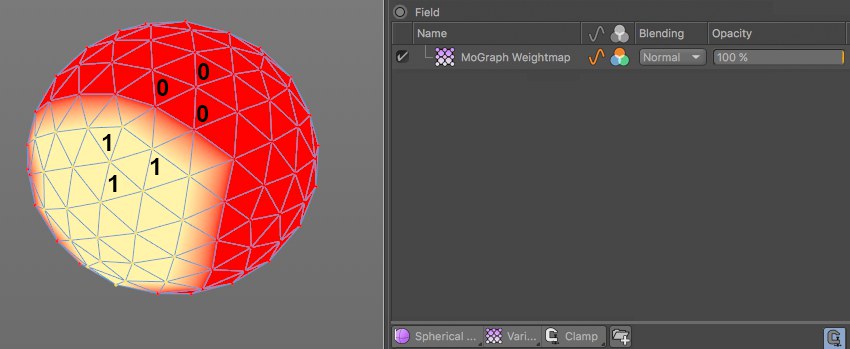 Variable Tag Field
Layer
Variable Tag Field
Layer
Variable Tag Field Layer
You can, for example, place the following tags into the Field list:
- Point, Edge and Polygon Selection tag spline field
- Vertex Maps and Colors
- MoGraph Selection and Weightmap tags
- Vertex Normal tags (currently, these output a constant vector length of 1 in the Values channel)
This means that Fields can also control all elements that use these tags:
- The Material tag uses polygon selections to which textures are restricted
- The Bevel Deformer uses polygon selections to restrict its effect
- The Restriction tag can use Vertex Map tags or Component Selection tags to restrict the effect of Deformers.
- The Vertex-Map-Shader can render Vertex Map and Vertex Color tags, etc.
Most of the aforementioned tags save a value for specific positions in space (object points or clone positions) for properties such as values, colors or vectors, which are referred to in the following as values. In principle, this is similar, for example, to what the Spherical Field does, which also generates values for positions in space.
It stands to reason that both should be combined (this works in both directions: Fields can also feed tags with values (Fields)). You can, therefore, create effects using the objects to which the tags are assigned (you can also build custom tools), or simply transfer effects from one tag to another (i.e., transferring the effect from a high-resolution object to a lower-resolution object and vice-versa can be easily done).
As soon as one of the above-mentioned tags is placed into the Field list, a Variable Tag Layer is generated, which is named after the tag.
 Here a sphere’s Vertex Map’s values takes effect
via a Variable Tag Layer. The Variable Tag Layer works analogous for other objects.
Here a sphere’s Vertex Map’s values takes effect
via a Variable Tag Layer. The Variable Tag Layer works analogous for other objects.
The Variable Tag Layer has several settings with which you can define how the tag values (that only exits at discreet positions, e.g., object points) should work.
Layers can read out values, colors and vectors. Since these can’t all be converted to the respective target sizes, it may be necessary to apply a Convert Field Layer. For example, if you want to control a color using a Normal tag, you will have to convert the vectors that the Normal tag uses to colors.